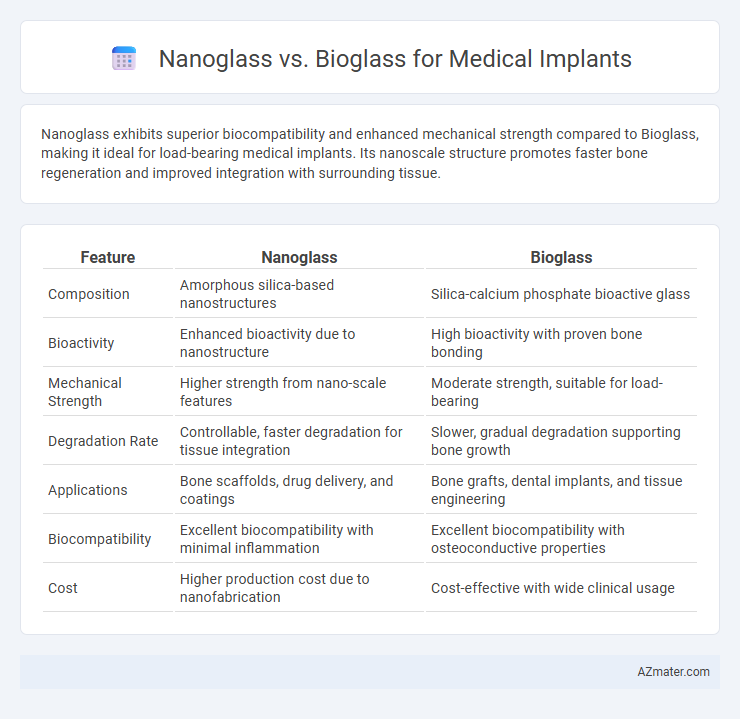Nanoglass exhibits superior biocompatibility and enhanced mechanical strength compared to Bioglass, making it ideal for load-bearing medical implants. Its nanoscale structure promotes faster bone regeneration and improved integration with surrounding tissue.
Table of Comparison
| Feature | Nanoglass | Bioglass |
|---|---|---|
| Composition | Amorphous silica-based nanostructures | Silica-calcium phosphate bioactive glass |
| Bioactivity | Enhanced bioactivity due to nanostructure | High bioactivity with proven bone bonding |
| Mechanical Strength | Higher strength from nano-scale features | Moderate strength, suitable for load-bearing |
| Degradation Rate | Controllable, faster degradation for tissue integration | Slower, gradual degradation supporting bone growth |
| Applications | Bone scaffolds, drug delivery, and coatings | Bone grafts, dental implants, and tissue engineering |
| Biocompatibility | Excellent biocompatibility with minimal inflammation | Excellent biocompatibility with osteoconductive properties |
| Cost | Higher production cost due to nanofabrication | Cost-effective with wide clinical usage |
Introduction to Nanoglass and Bioglass
Nanoglass and Bioglass are advanced biomaterials extensively used in medical implants for bone regeneration and tissue repair. Bioglass, a bioactive glass composed primarily of silica, calcium oxide, and phosphorus pentoxide, promotes strong bonding with bone through surface reactions that form hydroxyapatite. Nanoglass, a nanostructured glass with grain sizes below 100 nanometers, offers enhanced mechanical strength, increased bioactivity, and accelerated osseointegration compared to conventional Bioglass, making it highly suitable for load-bearing implants.
Key Properties of Nanoglass for Implants
Nanoglass exhibits superior bioactivity and enhanced mechanical strength compared to traditional Bioglass, making it highly suitable for medical implants. Its nanoscale structure facilitates rapid bone regeneration and improved cell adhesion, promoting faster healing and integration with surrounding tissues. The high surface area of Nanoglass also enables controlled ion release, which supports antibacterial properties and long-term implant stability.
Key Features of Bioglass for Medical Applications
Bioglass offers exceptional osteoconductivity and bioactivity, promoting rapid bone regeneration and strong bonding with surrounding tissues in medical implants. Its inherent ability to form a hydroxycarbonate apatite layer closely resembling natural bone mineral enhances integration and reduces healing time. The material's controlled biodegradability and antimicrobial properties minimize infection risk while supporting gradual replacement by native bone.
Biocompatibility: Nanoglass vs Bioglass
Nanoglass exhibits enhanced biocompatibility compared to traditional Bioglass due to its nanoscale surface features that promote superior cellular adhesion and proliferation. The increased surface area of Nanoglass facilitates accelerated hydroxyapatite formation, leading to improved osseointegration in medical implants. Bioglass remains effective in biocompatibility but may demonstrate slower tissue response and integration compared to Nanoglass-based materials.
Mechanical Strength and Durability Comparison
Nanoglass exhibits superior mechanical strength compared to Bioglass, owing to its ultra-fine nanostructured grains that enhance hardness and fracture toughness. The high density and improved atomic packing in Nanoglass contribute to increased durability under cyclic loading conditions, making it more resistant to wear and fatigue in medical implants. Bioglass, while biocompatible and bioactive, generally shows lower mechanical strength and durability, which may limit its use in load-bearing implant applications.
Osteointegration Potential in Nanoglass vs Bioglass
Nanoglass exhibits superior osteointegration potential compared to traditional Bioglass due to its enhanced surface area and nanoscale porosity, which promote greater cellular adhesion and proliferation. Studies demonstrate that Nanoglass stimulates more rapid hydroxyapatite formation, crucial for strong bone-implant bonding. The enhanced bioactivity and controlled ion release in Nanoglass contribute to faster and more efficient bone regeneration at the implant site.
Antibacterial Properties and Infection Resistance
Nanoglass exhibits superior antibacterial properties compared to traditional Bioglass, owing to its higher surface area and enhanced ion release, which disrupts bacterial cell walls more effectively. This increased ion exchange facilitates accelerated bioactivity and stronger infection resistance, making Nanoglass a preferred material for medical implants vulnerable to microbial colonization. Studies show Nanoglass implants reduce bacterial adhesion and biofilm formation, significantly lowering postoperative infection rates in clinical settings.
Clinical Applications in Orthopedic and Dental Implants
Nanoglass offers superior bioactivity and faster osseointegration compared to Bioglass, making it highly effective for orthopedic implants such as bone grafts and joint replacements. In dental implants, nanoglass enhances cell adhesion and antimicrobial properties, reducing infection risks and promoting quicker healing in periodontal treatments. Clinical studies demonstrate that nanoglass's nanoscale structure improves mechanical strength and durability, providing long-term stability in both orthopedic and dental applications.
Challenges and Limitations of Each Material
Nanoglass exhibits superior mechanical strength and bioactivity compared to Bioglass but faces challenges in scalability and uniform particle synthesis, which hinder consistent implant performance. Bioglass, while well-established for its excellent osteointegration and biocompatibility, suffers from brittleness and limited load-bearing capacity, restricting its use in highly stressed medical implants. Both materials require further innovation to overcome degradation control and long-term stability concerns in vivo.
Future Trends in Nanoglass and Bioglass Implant Technologies
Nanoglass and Bioglass are advancing medical implant technologies by enhancing bioactivity and tissue integration through nanostructured surfaces and ion release. Future trends emphasize the development of multifunctional nanoglass composites with improved mechanical strength, controlled drug delivery, and tailored degradation rates to better support bone regeneration and healing. Innovations in 3D printing and surface modification techniques are enabling more precise customization of bioglass implants to meet patient-specific anatomical and physiological requirements.

Infographic: Nanoglass vs Bioglass for Medical implant
 azmater.com
azmater.com